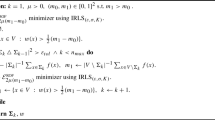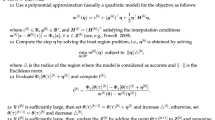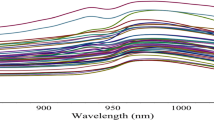Abstract
Kernel density estimation in domains with boundaries is known to suffer from undesirable boundary effects. We show that in the case of smooth densities, a general and elegant approach is to estimate an extension of the density. The resulting estimators in domains with boundaries have biases and variances expressed in terms of density extensions and extension parameters. The result is that they have the same rates at boundary and interior points of the domain. Contrary to the extant literature, our estimators require no kernel modification near the boundary and kernels commonly used for estimation on the real line can be applied. Densities defined on the half-axis and in a unit interval are considered. The results are applied to estimation of densities that are discontinuous or have discontinuous derivatives, where they yield the same rates of convergence as for smooth densities on \({\mathbb {R}}\).


Similar content being viewed by others
Notes
Let \(s \in \mathbb {N}\) and \(\Omega \subseteq {\mathbb {R}}\). The class of functions \(f:\Omega \rightarrow {\mathbb {R}}\) which are s-times differentiable with \(\left| f^{(s)}(x)\right| \le C\) for some \(0<C<\infty \) is denoted by \(\mathcal {C}_b^{s}(\Omega )\). We say that the kernel K is of order \(s \ge 2\) if \(\int t^jK(t)\mathrm{d}t=0\) for \(j=1,\ldots , s-1\) and \(\int t^{s}K(t)\mathrm{d}t \ne 0\).
Note that there is a typographical mistake in Schuster’s expression. Using his notation, the last kernel in his equation (2.5) should be evaluated at \((x-2d+X_i)/a\).
Results for \({\hat{f}}_{s,k}\) when \(w_i=i^{-1}\) are not shown, as the performance of these estimators is generally dominated by the case where \(w_i=i\). The full set of results, including experiments where \(n=1000\), is available from the authors upon request.
Specifically, we consider the estimator constructed using the kernel \(K_L\) defined on his equation (3.4).
References
Burenkov, V. I. (1998). Sobolev spaces on domains. Leipzig: B. G. Teubner.
Chen, S. X. (1999). Beta kernel estimators for density functions. Computational Statistics & Data Analysis, 31, 131–145.
Chen, S. X. (2000). Probability density function estimation using gamma kernels. Annals of the Institute of Statistical Mathematics, 52, 471–480.
Cheng, M.-Y. (1994). On boundary effects of smooth curve estimators. Ph.D. thesis, University of North Carolina-Chapel Hill, Department of Statistics.
Cline, D. B. H., Hart, J. D. (1991). Kernel estimation of densities with discontinuities or discontinuous derivatives. Statistics: A Journal of Theoretical and Applied Statistics, 22, 69–84.
Hestenes, M. R. (1941). Extension of the range of a differentiable function. Duke Mathematical Journal, 8, 183–192.
Jones, M. C. (1993). Simple boundary correction for kernel density estimation. Statistics and Computing, 3, 135–146.
Jones, M. C., Foster, P. J. (1993). Generalized jackknifing and higher order kernels. Journal of Nonparametric Statistics, 3, 81–94.
Karunamuni, R. J., Alberts, T. (2005). A generalized reflection method of boundary correction in kernel density estimation. The Canadian Journal of Statistics, 33, 497–509.
Malec, P., Schienle, M. (2014). Nonparametric kernel density estimation near the boundary. Computational Statistics & Data Analysis, 72, 57–76.
Marron, J. S., Ruppert, D. (1994). Transformations to reduce boundary bias in kernel density estimation. Journal of the Royal Statistical Society: Series B, 56, 653–671.
McCrary, J. (2008). Manipulation of the running variable in the regression discontinuity design. Journal of Econometrics, 142, 698–714.
Mynbaev, K., Martins-Filho, C. (2010). Bias reduction in kernel density estimation via Lipschitz condition. Journal of Nonparametric Statistics, 22, 219–235.
Mynbaev, K., Martins-Filho, C., Aipenova, A. (2016). A class of nonparametric density derivative estimators based on global Lipschitz conditions. Advances in Econometrics, 36, 591–615.
Schuster, E. F. (1985). Incorporating support constraints into nonparametric estimators of densities. Communications in Statistics - Theory and Methods, 14, 1123–1136.
Wen, K., Wu, X. (2015). An improved transformation-based kernel density estimator of densities on the unit interval. Journal of the American Statistical Association, 110, 773–783.
Author information
Authors and Affiliations
Corresponding author
Additional information
We thank two anonymous referees for their comments and the Institute of Mathematics and Mathematical Modeling for hosting our research. Any remaining errors are the authors’ responsibility. This project has been partially supported by N 0118PK00476 from the Ministry of Education and Science of the Republic of Kazakhstan.
Appendix: Proofs
Appendix: Proofs
Proof of Theorem 1
(1) By the IID assumption
In the first integral let \(u=\frac{x-t}{h}\), in the others \(u=\frac{x+t/w_{j}}{h}\). Then
In the first integral we have \(x-hu>0\) and \(f(x-hu)=g_s(x-hu)\); in the second one \(x-hu<0,\) so \(\sum _{j=1}^{s+1}k_{j}f\left( -w_{j}(x-hu)\right) =g_s(x-hu)\). Hence,
By Assumption 1\( \left| K^{(j)}(u)g_s^{(m-1-j)}(x-hu)\right| =o(1), \) as \(|u|\rightarrow \infty \) for \(j=0,\ldots ,m-1\), \(h>0\). Therefore, integration by parts gives (31)
Since \(\int _{\mathbb {R}} K(t)\mathrm{d}t=1\), this implies (6).
(2) Plug the definition of \(M_{k}\) in (30) to get
For \(l<0\), and after putting \(\frac{x-t}{lh} =u\) and \(\frac{x+t/w_{j}}{lh}=u\) on the first and second integrals
Similarly, we have for \(l>0\)
Therefore, (33) gives
Finally,
which is (7). \(\square \)
Proof of Theorem 2
For part (1), we note that since \(\int K(t)\mathrm{d}t =1\) we have from Theorem 1
for some \(\tau \in (0,1)\). If \(\int _{{\mathbb {R}}}K(t)t^{j}\mathrm{d}t=0\), for \(j=1,\ldots ,s-m-1\), then
where the last inequality follows from the assumptions that \(\int _{{\mathbb {R}}}\left| K(t)t^{s-m}\right| \mathrm{d}t<\infty \), \(\left| f^{(s)}(x)\right| <C\) for all \(x\ge 0\) and the structure of \(g^{(s)}\). For part 2), using (7) and Hölder’s inequality we have
In the last line, we used the bound \(\left\| g_s^{(m)}\right\| _{B_{p,q}^{r}({\mathbb {R}})}\le c\left\| f^{(m)}\right\| _{B_{p,q}^{r}(0,\infty )}\). \(\square \)
Proof of Theorem 4
(1) Let \(I_{A}\) denote the indicator of a set A. Then, for an arbitrary function g, \(\sum _{X_{i}<aw_{j}}g(X_{i})=\sum _{i=1}^{n}I_{\{X_{i}<aw_{j}\}}g(X_{i})\). Using indicators in (15) and the fact that \(\{X_i\}_{i=1}^n\) is IID, we have
Changing variables using \(\frac{x-t}{h}=u\), \(\frac{x+t/w_{j}}{h}=u\), \(\frac{x-1+(t-1)/w_{j}}{h}=u\), we have
Applying (14), we have
Regardless of \(x\in [0,1],\) the interval \(((x-1-a)/h,(x+a)/h)\) contains \((-a/h,a/h)\) which contains \({\mathrm {supp}} K\) for all small h. Therefore,
For this to hold formally, \(g_s\) should be extended outside \((-a,1+a)\) smoothly; the manner of extension does not affect the above integral. Finally, integration by parts and the condition \(\int _{\mathbb {R}} K(t)\mathrm{d}t=1\) prove the statement.
(2) Since K is assumed to have finite support, we do not need Assumption 1. Calculations done in the proof of Theorem 2 after Eq. (33) include change of variables and integration by parts and can be easily repeated here. \(\square \)
Proof of Theorem 5
Define
Then \(V\left( {\hat{f}}_{s}^{(m)}(x)\right) =\frac{1}{n}[Eu_1^2-(Eu_1)^2]\). It will be shown that \(Eu_1^2\) is of order \(h^{-(2m+1)}\) in all cases. Since \(Eu_1=O(1)\) by Theorem 4, it is enough to find the exact order of \(Eu_1^2\). Letting \(F=K^{(m)}\), denote
g is used at internal points of the domain, \(g_{i}^{l}\) and \(g_{i}^{r}\) are used for correction at the left and right boundaries, respectively. Their contributions to variances reflect this. From
we see that \(Eu_{1}^{2}\) contains (a) \(Eg^{2},\) (b) \(Egg_{i}^{l},\) (c) \( Eg_{i}^{l}g_{j}^{l},\) (d) \(Egg_{j}^{r},\) (e) \(Eg_i^{l}g_{j}^{r}\), (f) \(Eg_{i}^{r}g_{j}^{r}.\)
-
(I)
Let \(x\in (0,1).\)
-
(a)
Replacing \(\frac{x-t}{h}=u,\) we have
$$\begin{aligned} \frac{1}{h}Eg^{2}=\frac{1}{h}\int _{0}^{1}F^{2}\left( \frac{x-t}{h}\right) f(t)\mathrm{d}t=\int _{(x-1)/h}^{x/h}F^{2}(u)f(x-hu)\mathrm{d}u. \end{aligned}$$(36)Since \(x/h\rightarrow \infty ,\)\((x-1)/h\rightarrow -\infty \) and f is bounded and continuous, in the equation
$$\begin{aligned} \frac{1}{h}Eg^{2}= & {} -\int _{x/h}^{\infty }F^{2}(u)f(x-hu)\mathrm{d}u-\int _{-\infty }^{(x-1)/h}F^{2}(u)f(x-hu)\mathrm{d}u\\&+\int _{\mathbb {R}}F^{2}(u)f(x-hu)\mathrm{d}u \end{aligned}$$the first two integrals on the right tend to zero and the last integral tends to \(f(x)\Gamma \) by the dominated convergence theorem. Thus,
$$\begin{aligned} \frac{1}{h}Eg^{2}=f(x)\Gamma +o(1). \end{aligned}$$(37)Similar arguments below will be omitted.
-
(b)
Here we use boundedness of f, F and integrability of F:
$$\begin{aligned} \left| \frac{1}{h}Egg_{i}^{l}\right|= & {} \left| \frac{1}{h} \int _{0}^{aw_{i}}F\left( \frac{x-t}{h}\right) F\left( \frac{x+t/w_{i}}{h} \right) f(t)\mathrm{d}t\right| \nonumber \\&\left( \text {replacing }\frac{x+t/w_{i}}{h} =u\text { and using dots in place of inconsequential arguments}\right) \nonumber \\= & {} w_{i}\left| \int _{x/h}^{(x+a)/h}F\left( \cdots \right) F\left( u\right) f(\cdots )\mathrm{d}u\right| \le w_{i}\sup \left| fF\right| \int _{x/h}^{(x+a)/h}|F\left( u\right) |\mathrm{d}u\rightarrow 0. \nonumber \\ \end{aligned}$$(38) -
(c)
Denoting \(\lambda =\min \{w_{i},w_{j}\}\), we have
$$\begin{aligned} \frac{1}{h}Eg_{i}^{l}g_{j}^{l}= & {} \frac{1}{h}\int _{0}^{a\lambda }F\left( \frac{x+t/w_{i}}{h}\right) F\left( \frac{x+t/w_{j}}{h}\right) f(t)\mathrm{d}t \nonumber \\&\left( \text {replacing }\frac{x+t/w_{i}}{h} =u\right) \nonumber \\= & {} w_{i}\int _{x/h}^{(x+a\lambda /w_{i})/h}F\left( \cdots \right) F\left( u\right) f(\cdots )\mathrm{d}u\rightarrow 0. \end{aligned}$$(39) -
(d)
Replacing \(\frac{x-1+(t-1)/w_{i}}{h}=u\), we get
$$\begin{aligned} \frac{1}{h}Egg_{i}^{r}= & {} \frac{1}{h}\int _{1-aw_{i}}^{1}F\left( \frac{x-t}{h} \right) F\left( \frac{x-1+(t-1)/w_{i}}{h}\right) f(t)\mathrm{d}t \nonumber \\= & {} w_{i}\int _{(x-1-a)/h}^{(x-1)/h}F\left( \cdots \right) F\left( u\right) f(\cdots )\mathrm{d}u\rightarrow 0. \end{aligned}$$(40) -
(e)
Replacing \(\frac{x+t/w_{i}}{h}=u\)
$$\begin{aligned} \frac{1}{h}Eg_{i}^{l}g_{j}^{r}= & {} \frac{1}{h}\int _{1-aw_{j}}^{aw_{i}}F\left( \frac{x+t/w_{i}}{h}\right) F\left( \frac{x-1+(t-1)/w_{j}}{h}\right) f(t)\mathrm{d}t \nonumber \\= & {} w_{i}\int _{[x+(1-aw_{j})/w_{i}]/h}^{(x+a)/h}F\left( u\right) F\left( \cdots \right) f(\cdots )\mathrm{d}u\rightarrow 0. \end{aligned}$$(41)Here we take into account that \(aw_{j}\le 1\) for all j.
-
(f)
Letting \(\lambda =\min \{w_{i},w_{j}\}\) we have
$$\begin{aligned} \frac{1}{h}Eg_{i}^{r}g_{j}^{r}= & {} \frac{1}{h}\int _{1-a\lambda }^{1}F\left( \frac{x-1+(t-1)/w_{i}}{h}\right) \nonumber \\&\times F\left( \frac{x-1+(t-1)/w_{j}}{h}\right) f(t)\mathrm{d}t \nonumber \\&\left( \text {replacing }\frac{x-1+(t-1)/w_{i}}{h}=u\right) \nonumber \\= & {} w_{i}\int _{(x-1-a\lambda /w_{i})/h}^{(x-1)/h}F\left( u\right) F\left( \cdots \right) f(\cdots )\mathrm{d}u\rightarrow 0. \end{aligned}$$(42)The conclusion from (37) to (42) is that \(Eu_{1}^{2}=\frac{1}{h^{2m+1}} \left\{ f(x)\Gamma +o(1)\right\} \) which proves statement I).
-
(a)
-
(II)
Let \(x=0.\)
-
(a)
From (36)
$$\begin{aligned} \frac{1}{h}Eg^{2}= & {} \int _{-1/h}^{0}F^{2}(u)f(-hu)\mathrm{d}u\rightarrow f(0)\int _{-\infty }^{0}F^{2}(u)\mathrm{d}u\nonumber \\= & {} f(0)\int _{0}^{\infty }F^{2}\left( \frac{u}{ w_{0}}\right) \mathrm{d}u. \end{aligned}$$(43) -
(b)
By (38)
$$\begin{aligned} \frac{1}{h}Egg_{i}^{l}= & {} \frac{1}{h}\int _{0}^{aw_{i}}F\left( -\frac{t}{h} \right) F\left( \frac{t}{hw_{i}}\right) f(t)\mathrm{d}t\ \ \ \ \ \ \ \ \ \left( \text { replacing }\frac{t}{h}=u\right) \nonumber \\= & {} \int _{0}^{aw_{i}/h}F\left( -u\right) F\left( \frac{u}{w_{i}}\right) f(hu)\mathrm{d}u\rightarrow f(0)\nonumber \\&\times \int _{0}^{\infty }F\left( -u\right) F\left( \frac{u}{ w_{i}}\right) \mathrm{d}u \nonumber \\= & {} f(0)\int _{0}^{\infty }F\left( \frac{u}{w_{0}}\right) F\left( \frac{u}{ w_{i}}\right) \mathrm{d}u. \end{aligned}$$(44) -
(c)
By (39)
$$\begin{aligned} \frac{1}{h}Eg_{i}^{l}g_{j}^{l}= & {} \frac{1}{h}\int _{0}^{a\lambda }F\left( \frac{t/w_{i}}{h}\right) F\left( \frac{t/w_{j}}{h}\right) f(t)\mathrm{d}t\ \ \ \ \ \ \left( \text {replacing }\frac{t}{h}=u\right) \nonumber \\= & {} \int _{0}^{a\lambda /h}F\left( \frac{u}{w_{i}}\right) F\left( \frac{u}{ w_{j}}\right) f(hu)\mathrm{d}u\rightarrow f(0)\nonumber \\&\times \int _{0}^{\infty }F\left( \frac{u}{w_{i} }\right) F\left( \frac{u}{w_{i}}\right) \mathrm{d}u. \end{aligned}$$(45) -
(d)
By (40)
$$\begin{aligned} \frac{1}{h}Egg_{j}^{r}=w_{j}\int _{(-1-a)/h}^{-1/h}F\left( \cdots \right) F\left( u\right) f(\cdots )\mathrm{d}u\rightarrow 0. \end{aligned}$$(46) -
(e)
From (41)
$$\begin{aligned} \frac{1}{h}Eg_{i}^{l}g_{j}^{r}= & {} \frac{1}{h}\int _{1-aw_{j}}^{aw_{i}}F\left( \frac{t/w_{i}}{h}\right) F\left( \frac{-1+(t-1)/w_{j}}{h}\right) f(t)\mathrm{d}t \nonumber \\&\left( \text {here we replace }\frac{-1+(t-1)/w_{j}}{h} =u\right) \nonumber \\= & {} w_{j}\int _{(-1-a)/h}^{[-1+(aw_{i}-1)/w_{j}]/h}F\left( \cdots \right) F\left( u\right) f(\cdots )\mathrm{d}u\rightarrow 0. \end{aligned}$$(47)Here we remember that \(aw_{i}\le 1.\)
-
(f)
From (42)
$$\begin{aligned} \frac{1}{h}Eg_{i}^{r}g_{j}^{r}=w_{i}\int _{(-1-a\lambda /w_{i})/h}^{-1/h}F\left( u\right) F\left( \cdots \right) f(\cdots )\mathrm{d}u\rightarrow 0. \end{aligned}$$(48)From (43) to (48), we conclude that
$$\begin{aligned} Eu_{1}^{2}= & {} \frac{1}{h^{2m+1}}\left\{ f(0)\int _{0}^{\infty }F^{2}\left( \frac{u}{w_{0}}\right) \mathrm{d}u\right. \\&+\,2f(0)\sum _{i=1}^{s+1}\frac{k_{i}}{w_{i}} \int _{0}^{\infty }F\left( \frac{u}{w_{0}}\right) F\left( \frac{u}{w_{i}} \right) \mathrm{d}u\\&\left. +\,f(0)\sum _{i,j=1}^{s+1}\frac{k_{i}}{w_{i}}\frac{k_{j}}{w_{j}} \int _{0}^{\infty }F\left( \frac{u}{w_{i}}\right) F\left( \frac{u}{w_{j}} \right) \mathrm{d}u+o(1)\right\} \\= & {} \frac{1}{h^{2m+1}}\left\{ f(0)\int _{0}^{\infty }\left[ \sum _{i=0}^{s+1} \frac{k_{i}}{w_{i}}F\left( \frac{u}{w_{i}}\right) \right] ^{2}\mathrm{d}u+o(1)\right\} . \end{aligned}$$
-
(a)
-
(III)
Let \(x=1.\)
-
(a)
From (36)
$$\begin{aligned} \frac{1}{h}Eg^{2}= & {} \int _{0}^{1/h}F^{2}(u)f(1-hu)\mathrm{d}u\rightarrow f(1)\int _{0}^{\infty }F^{2}\left( u\right) \mathrm{d}u\nonumber \\= & {} f(1)\int _{-\infty }^{0}F^{2}\left( \frac{u}{w_{0}}\right) \mathrm{d}u. \end{aligned}$$(49) -
(b)
From the second line of (38)
$$\begin{aligned} \frac{1}{h}Egg_{i}^{l}=w_{i}\int _{1/h}^{(1+a)/h}F\left( \cdots \right) F\left( u\right) f(\cdots )\mathrm{d}u\rightarrow 0. \end{aligned}$$(50) -
(c)
From the last line of (39)
$$\begin{aligned} \frac{1}{h}Eg_{i}^{l}g_{j}^{l}=w_{i}\int _{1/h}^{(1+a\lambda /w_{i})/h}F\left( \cdots \right) F\left( u\right) f(\cdots )\mathrm{d}u\rightarrow 0. \end{aligned}$$(51) -
(d)
From (40)
$$\begin{aligned} \frac{1}{h}Egg_{i}^{r}= & {} \frac{1}{h}\int _{1-aw_{i}}^{1}F\left( \frac{1-t}{h} \right) \nonumber \\&\times F\left( \frac{(t-1)/w_{i}}{h}\right) f(t)\mathrm{d}t\ \ \ \ \ \ \left( \text { replacing }\frac{t-1}{h}=u\right) \nonumber \\= & {} \int _{-aw_{i}/h}^{0}F\left( -u\right) F\left( \frac{u}{w_{i}}\right) f(1+hu)\mathrm{d}u \nonumber \\\rightarrow & {} f(1)\int _{-\infty }^{0}F\left( -u\right) F\left( \frac{u}{w_{i} }\right) \mathrm{d}u\nonumber \\= & {} f(1)\int _{-\infty }^{0}F\left( \frac{u}{w_{0}}\right) F\left( \frac{u}{w_{i}}\right) \mathrm{d}u. \end{aligned}$$(52) -
(e)
From (41)
$$\begin{aligned} \frac{1}{h}Eg_{i}^{l}g_{j}^{r}= & {} \frac{1}{h}\int _{1-aw_{j}}^{aw_{i}}F\left( \frac{1+t/w_{i}}{h}\right) F\left( \frac{(t-1)/w_{j}}{h}\right) f(t)\mathrm{d}t \nonumber \\&\left( \text {replace }\frac{1+t/w_{i}}{h} =u\right) \nonumber \\= & {} w_{i}\int _{[1+(1-aw_{j})/w_{i}]/h}^{(1+a)/h}F\left( u\right) F\left( \cdots \right) f(\cdots )\mathrm{d}u\rightarrow 0. \end{aligned}$$(53) -
(f)
From (42)
$$\begin{aligned} \frac{1}{h}Eg_{i}^{r}g_{j}^{r}= & {} \frac{1}{h}\int _{1-a\lambda }^{1}F\left( \frac{t-1}{hw_{i}}\right) \nonumber \\&\times F\left( \frac{t-1}{hw_{j}}\right) f(t)\mathrm{d}t \ \ \ \ \left( \text {replacing }\frac{t-1}{h} =u\right) \nonumber \\= & {} \int _{-a\lambda /h}^{0}F\left( \frac{u}{w_{i}}\right) F\left( \frac{u}{ w_{j}}\right) f(1+hu)\mathrm{d}u\nonumber \\\rightarrow & {} f(1)\int _{-\infty }^{0}F\left( \frac{u}{ w_{i}}\right) F\left( \frac{u}{w_{j}}\right) \mathrm{d}u. \end{aligned}$$(54)Collecting nonzero limits from (49), (52), (54)
$$\begin{aligned} Eu_{1}^{2}= & {} \frac{1}{h^{2m+1}}\left\{ f(1)\int _{-\infty }^{0}F^{2}\left( \frac{u}{w_{0}}\right) \mathrm{d}u\right. \\&+\,2f(1)\sum _{i=1}^{s+1}\frac{k_{i}}{w_{i}} \int _{-\infty }^{0}F\left( \frac{u}{w_{0}}\right) F\left( \frac{u}{w_{i}} \right) \mathrm{d}u\\&\left. +\,f(1)\sum _{i,j=1}^{s+1}\frac{k_{i}}{w_{i}}\frac{k_{j}}{w_{j}} \int _{-\infty }^{0}F\left( \frac{u}{w_{i}}\right) F\left( \frac{u}{w_{i}} \right) \mathrm{d}u+o(1)\right\} \\= & {} \frac{1}{h^{2m+1}}\left\{ f(1)\int _{-\infty }^{0}\left[ \sum _{i=0}^{s+1} \frac{k_{i}}{w_{i}}F\left( \frac{u}{w_{i}}\right) \right] ^{2}\mathrm{d}u+o(1)\right\} . \end{aligned}$$
-
(a)
\(\square \)
Proof of Theorem 6
-
(1)
Instead of (30), we have
$$\begin{aligned} E{\hat{f}}_{+,s}^{(m)}(x)= & {} \frac{1}{h^{m+1}}E\left\{ I_{\{X_{1} \ge 0\}}\left[ K^{(m)}\left( \frac{x-X_{1}}{h}\right) \right. \right. \\&\left. \left. +\sum _{j=1}^{s+1}\frac{k_{j}}{w_{j}} K^{(m)}\left( \frac{x+X_{1}/w_{j}}{h}\right) \right] \right\} \\= & {} \frac{1}{h^{m+1}}\left[ \int _{0}^{\infty }K^{(m)}\left( \frac{x-t}{h} \right) f_{+}(t)\mathrm{d}t\right. \\&\left. +\sum _{j=1}^{s+1}\frac{k_{j}}{w_{j}}\int _{0}^{\infty }K^{(m)}\left( \frac{x+t/w_{j}}{h}\right) f_{+}(t)\mathrm{d}t\right] . \end{aligned}$$Repeating calculations that led from (30) to (32), we get
$$\begin{aligned} E{\hat{f}}_{+,s}^{(m)}(x)=\int _{{\mathbb {R}}}K\left( s\right) g_{+,s}^{(m)}(x-hs)ds \end{aligned}$$(those calculations did not use the fact that f was a density).
-
(2)
The proof is similar to that of Theorem 5.
\(\square \)
Proof of Theorem 7
By the i.i.d. assumption
The obvious changes of variables are:
The mean value becomes
Applying (19) we see that this is the same as
Regardless of \(x\in [c,d],\) the interval \(((x-d-a)/h,(x-c+a)/h)\) contains \((-a/h,a/h)\) which contains \({\mathrm {supp}}K\) for all small h. Therefore, also integrating by parts,
The derivation of the expression for variance largely repeats that from Theorem 5. \(\square \)
Proof of Theorem 8
(21) implies
for \(j=0,\ldots ,l-m\), so (23) is satisfied.
To prove (24), consider two cases.
Case\(xh^{-\alpha }\ge 1.\) (24) follows trivially from (8) because \({\tilde{f}}^{(m)}(x)={\hat{f}}^{(m)}(x).\)
Case\(xh^{-\alpha }\le 1.\) Obviously, in the equation
the first term on the right is \(O(h^{s-m}),\) and it remains to prove that \( \left[ \psi (xh^{-\alpha })-1\right] f^{(m)}(x)=O(h^{s-m}).\) Suppose (22) is true, so that \(\alpha =1.\) Then
Suppose (22) is wrong. Then \(\alpha =\frac{s-m}{k-m}\) and
(55) and (56) prove what we need.
To prove (25), consider two cases.
Case\(xh^{-\alpha }\ge 1.\) The first part of (25) is obvious because \({\tilde{f}}^{(m)}(x)={\hat{f}}^{(m)}(x).\)
Case\(xh^{-\alpha }\le 1.\) From (35) it follows that
which proves the second part of (25). \(\square \)
Proof of Theorem 9
For almost all samples \(\min _{i}X_{i}>0\) and for \(0<x\le \frac{1 }{3}\min _{i}X_{i}\), one has \(\psi (X_{i}/x)=0,\)\(i=1,\ldots ,n.\) Hence \({\hat{f}} ^{(m)}(x)\) vanishes, together with all its derivatives, in the neighborhood of zero for almost all samples. Following (30), we see that the mean is
Here the function \(f_{x}(t)=f(t)\psi \left( t/x\right) \) has support \(\mathrm{supp}f_{x}\subseteq [0,3x].\) Implementing changes applied after (31), including integration by parts, we obtain an analog of (32) with \(g_{x}\) instead of g. \(g_{x}\) is obtained by replacing f in (2)–(3) by \( f_{x}.\) The rest is familiar.
The statement about variance is obtained by repeating the corresponding part of the proof of Theorem 5. \(\square \)
About this article
Cite this article
Mynbaev, K., Martins-Filho, C. Unified estimation of densities on bounded and unbounded domains. Ann Inst Stat Math 71, 853–887 (2019). https://doi.org/10.1007/s10463-018-0663-z
Received:
Revised:
Published:
Issue Date:
DOI: https://doi.org/10.1007/s10463-018-0663-z




